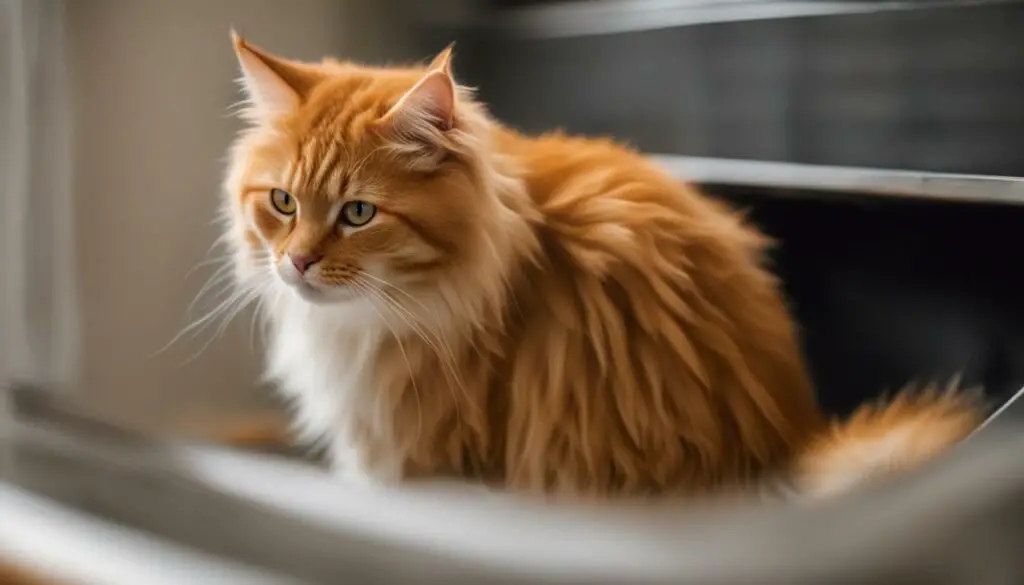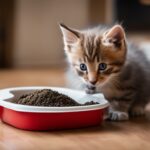Have you ever wondered why your cat grunts while pooping? It’s a common behavior that can sometimes be concerning. But fear not, understanding the reasons behind this behavior is crucial for your cat’s health and well-being.
Cats, like humans, can make various sounds when they’re doing their business. And those grunting noises during pooping can actually be quite normal. In this guide, I’ll explain the possible causes of your cat’s grunting, how to identify constipation, and what you can do to help your furry friend.
Key Takeaways:
- Cats sometimes grunt while pooping, which is usually normal.
- Constipation can be a common cause of grunting during bowel movements.
- Look out for symptoms of constipation in your cat, such as infrequent or small bowel movements, straining, abdominal discomfort, loss of appetite, and lethargy.
- Factors like age, dehydration, lack of fiber in the diet, sedentary lifestyle, and certain health conditions can increase your cat’s risk of constipation.
- To prevent and manage constipation, ensure your cat has a balanced diet, stays hydrated, and gets regular exercise.
Common Causes of Grunting During Cat’s Bowel Movements
When it comes to understanding why your cat grunts when pooping, there are several common causes to consider. One of the primary reasons is cat constipation. This occurs when the stool hardens and becomes difficult to pass through the digestive system. The hardness of the stool can lead to discomfort and pain, resulting in grunting noises during bowel movements.
In addition to constipation, other potential causes of grunting during a cat’s bowel movements include dietary issues, dehydration, and underlying health conditions affecting the cat’s digestive system. For example, if your cat’s diet lacks sufficient fiber, it can lead to difficulties in passing stool smoothly. Dehydration can also contribute to the hardening of stool, making it more challenging to pass. In some cases, there may be underlying health conditions that affect the cat’s bowel movements, such as gastrointestinal disorders or anal gland issues.
It’s important to monitor your cat’s bowel movements and be observant of any grunting sounds. If you notice your cat consistently grunting during pooping or experiencing other signs of discomfort, it is recommended to consult with a veterinarian for further evaluation and guidance. They can assess your cat’s overall health, identify any underlying issues, and provide appropriate treatment options to alleviate constipation or address other potential causes.
Common Causes of Grunting During Cat’s Bowel Movements:
| Cause | Description |
|---|---|
| Constipation | Hardened stool making it difficult to pass |
| Dietary issues | Lack of sufficient fiber in the diet |
| Dehydration | Insufficient water intake leading to hardened stool |
| Underlying health conditions | Gastrointestinal disorders or anal gland issues |
Understanding the common causes behind your cat’s grunting during bowel movements can help you address the issue and ensure your cat’s overall well-being. By addressing constipation, dietary issues, dehydration, or underlying health conditions, you can work towards promoting regular and comfortable bowel movements for your feline friend.
Symptoms of Constipation in Cats
Cats can experience constipation, a condition in which they struggle to have regular and comfortable bowel movements. Recognizing the symptoms of constipation is important for identifying and addressing the issue promptly. Here are some common signs to look out for:
Signs and Symptoms of Constipation in Cats:
- Infrequent or small bowel movements
- Straining or grunting during pooping
- Abdominal discomfort or bloating
- Loss of appetite or reduced food intake
- Lethargy or decreased activity levels
If you notice these symptoms in your cat, it is possible that they are struggling with constipation. When constipated, cats may experience difficulty in passing stool, resulting in discomfort and a disruption of their regular bathroom routine.
It’s important to note that these symptoms can also indicate other underlying health issues. Therefore, it is crucial to consult with a veterinarian for a proper evaluation and diagnosis. A veterinarian will be able to determine the cause of your cat’s constipation and recommend appropriate treatment options.
| Causes of Cat Constipation | Treatment Options |
|---|---|
|
|
Remember, if you notice any signs of constipation in your cat, it’s important to seek veterinary care. Your veterinarian will be able to provide the necessary guidance and treatment to ensure your cat’s comfort and well-being.
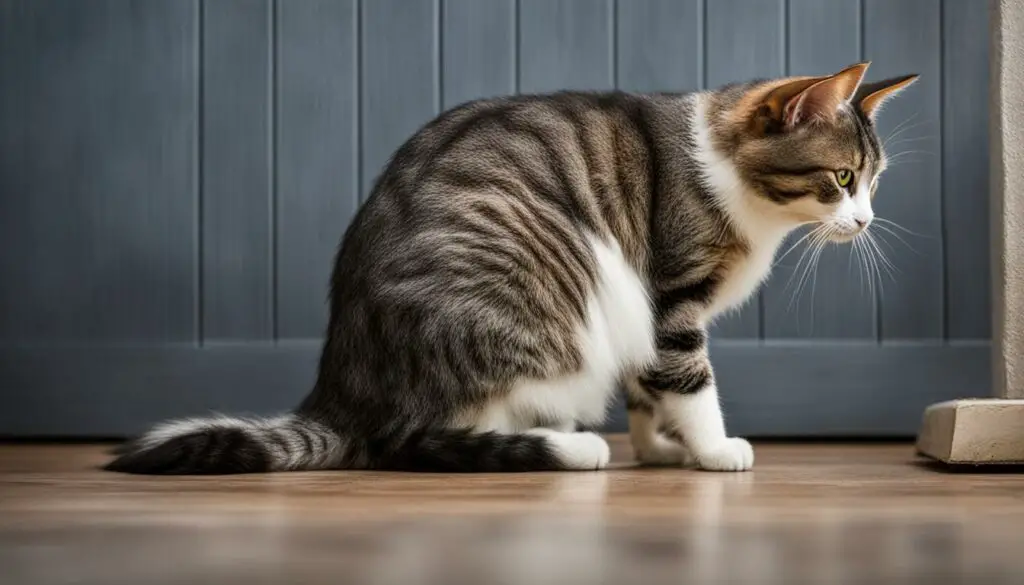
Risk Factors for Cat Constipation
Understanding the risk factors for cat constipation can help you take proactive measures to prevent this uncomfortable condition. Several factors can increase the likelihood of your cat experiencing constipation:
- Age: Older cats are more prone to constipation due to reduced muscle tone in their digestive system.
- Dehydration: Insufficient water intake can lead to dry and hard stools, making them difficult to pass.
- Lack of dietary fiber: A diet low in fiber can contribute to constipation as fiber adds bulk to the stool and facilitates smooth bowel movements.
- Sedentary lifestyle: Cats who lead a sedentary lifestyle without enough exercise may experience poor digestion and slower bowel movements.
- Health conditions: Certain medical conditions like megacolon (abnormally enlarged colon) or pelvic injuries can affect the cat’s ability to eliminate waste properly.
By keeping these risk factors in mind, you can make informed choices and take preventive actions to promote your cat’s overall digestive health.
| Risk Factors | Preventive Measures |
|---|---|
| Age | Regular exercise and a balanced diet |
| Dehydration | Ensure fresh water is always available and monitor water intake |
| Lack of dietary fiber | Feed a high-fiber diet or consider fiber supplements approved by your veterinarian |
| Sedentary lifestyle | Encourage physical activity through play and interactive toys |
| Health conditions | Regular veterinary check-ups and prompt treatment of any underlying health issues |
By addressing these risk factors and implementing preventive measures, you can significantly reduce the chances of your cat developing constipation and ensure their digestive system functions smoothly.
Prevention and Management of Cat Constipation
If you want to ensure your cat’s digestive system stays healthy and prevent constipation, there are several preventive measures and management strategies you can implement. By following these tips, you can help your cat maintain regular bowel movements and minimize the risk of constipation.
Dietary Considerations
A balanced diet plays a crucial role in preventing constipation in cats. Make sure to provide your cat with high-quality, fiber-rich cat food that promotes healthy digestion. Fiber helps add bulk to the stool, making it easier for cats to pass. Consult with your veterinarian to determine the appropriate type and amount of fiber suitable for your cat’s specific needs.
Additionally, ensure your cat has access to fresh water at all times. Proper hydration is essential for maintaining normal bowel movements and preventing constipation. You can encourage your cat to drink more water by providing multiple water sources throughout your home and using a cat fountain or adding water to their wet food.
Regular Exercise
Regular exercise is beneficial for your cat’s overall health, including their digestive system. Physical activity helps stimulate bowel movements and promotes regularity. Engage your cat in interactive play sessions, provide toys that encourage movement, or consider using puzzle feeders to make mealtime more engaging and active.
| Prevention and Management Tips | |
|---|---|
| Tip 1: | Incorporate fiber-rich cat food into your cat’s diet. |
| Tip 2: | Ensure your cat has access to fresh water at all times. |
| Tip 3: | Engage your cat in regular exercise and play sessions. |
| Tip 4: | Consider adding a digestive supplement or probiotics to your cat’s diet. |
| Tip 5: | Provide a stress-free litter box environment for your cat. |
Supplements and Probiotics
In some cases, your veterinarian may recommend incorporating dietary supplements or probiotics into your cat’s routine to promote healthy digestion. These supplements can help maintain a healthy balance of gut bacteria and support regular bowel movements. It’s important to consult with your vet before introducing any new supplements to your cat’s diet.
Litter Box Environment
Creating a stress-free litter box environment is essential for preventing constipation in cats. Ensure that the litter box is easily accessible and located in a quiet area of your home. Use a litter box with low sides, allowing your cat to enter and exit comfortably. Regularly clean the litter box to maintain cleanliness and avoid odors that may deter your cat from using it.
By implementing these preventive measures and management strategies, you can help promote your cat’s overall digestive health and prevent constipation. However, if your cat continues to experience constipation or if the condition worsens, it’s important to consult your veterinarian for a comprehensive evaluation and appropriate treatment.
Home Care for Constipated Cats
When it comes to mild cases of cat constipation, there are several home care measures you can try to help alleviate the issue and promote regular bowel movements. Here are some simple steps you can take:
- Increase water intake: Ensuring your cat stays hydrated is crucial for preventing constipation. Provide fresh water in multiple locations throughout the house and consider using a pet fountain to encourage drinking.
- Add fiber to their diet: Fiber can help soften the stool and promote regular bowel movements. You can try incorporating canned pumpkin, psyllium husk, or a specialized cat food formulated for digestive health into their diet. However, it’s important to consult with your veterinarian before making any dietary changes.
- Maintain litter box hygiene: A clean litter box can help reduce stress and encourage your cat to use it regularly. Scoop the litter box daily and ensure there is enough litter for your cat to dig and cover their waste properly.
- Encourage physical activity: Regular exercise can help stimulate the digestive system and promote healthy bowel movements. Engage your cat in playtime sessions and provide opportunities for climbing, scratching, and exploring.
Remember, these home care measures are suitable for mild cases of constipation. If your cat’s symptoms persist or worsen, it’s important to seek veterinary advice for proper evaluation and treatment. They can provide guidance tailored to your cat’s specific needs and ensure their overall health and well-being.
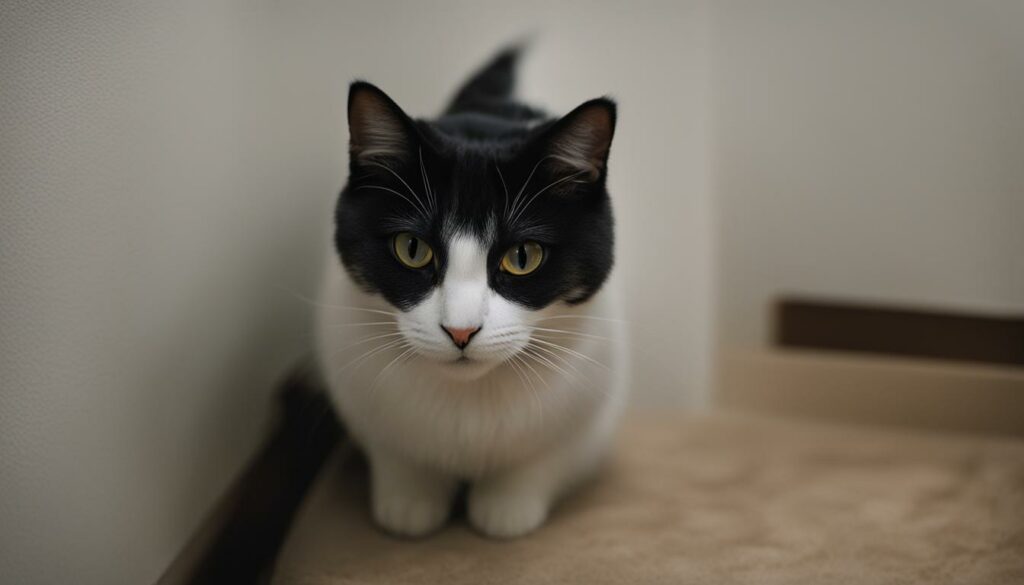
Table: Comparison of Home Care Measures for Constipated Cats
| Home Care Measures | Effectiveness | Considerations |
|---|---|---|
| Increase water intake | ✅ | Ensure fresh water is always available; consider using a pet fountain |
| Add fiber to their diet | ✅ | Consult with a veterinarian before making dietary changes |
| Maintain litter box hygiene | ✅ | Scoop the litter box daily; provide enough litter for digging and covering waste |
| Encourage physical activity | ✅ | Engage your cat in playtime and provide opportunities for exercise |
Veterinary Treatment for Cat Constipation
When it comes to more severe cases of cat constipation, seeking veterinary treatment is crucial. Your veterinarian has the expertise to assess your cat’s condition and recommend the necessary interventions to relieve their constipation and promote healthy bowel movements.
In veterinary treatment for cat constipation, there are several options that your veterinarian may consider. These include:
- Medications: Your veterinarian may prescribe medications to help soften the stool and facilitate easier passage through the digestive system.
- Stool softeners: In some cases, stool softeners may be recommended to alleviate constipation by adding moisture to the stool.
- Enemas: Enemas can be used to introduce liquids into the rectum to soften and lubricate the stool, making it easier to pass.
- Manual removal of fecal matter: In severe cases, your veterinarian may need to manually remove impacted feces from your cat’s rectum. This should only be done by a trained professional to avoid causing any harm or injury to your cat.
It’s important to note that veterinary treatment for cat constipation should always be carried out under the guidance and supervision of a qualified veterinarian. They will determine the most appropriate course of action based on your cat’s individual needs and circumstances.
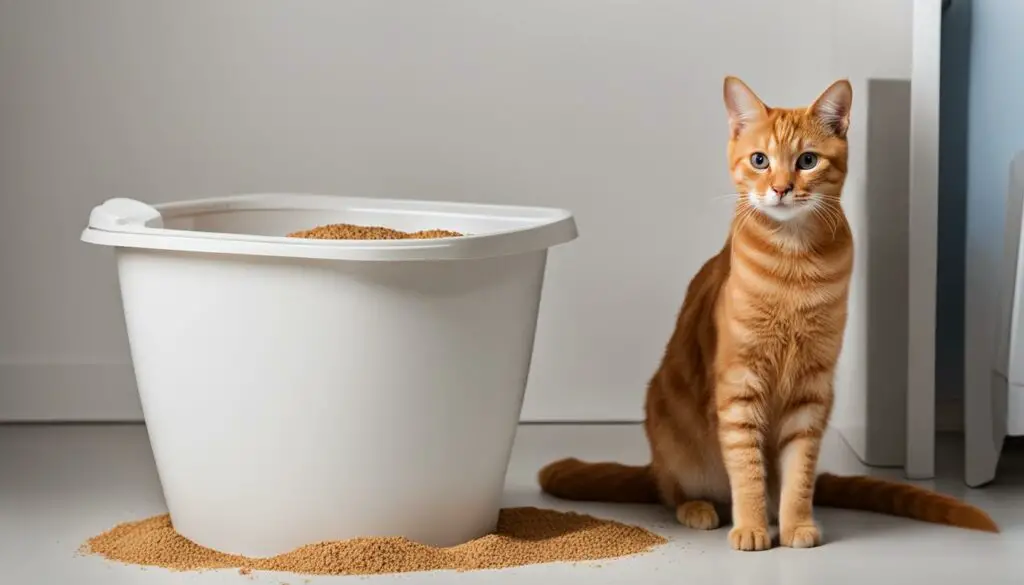
When to Seek Veterinary Help for Cat Constipation
If your cat is experiencing constipation and home care measures have not provided relief within a day or two, it is advisable to seek veterinary help. Additionally, if your cat exhibits severe symptoms such as vomiting, abdominal pain, or lethargy, it’s important to consult with a veterinarian as soon as possible. These symptoms could indicate a more serious underlying health issue that requires immediate attention.
| Veterinary Treatment Options for Cat Constipation | Details |
|---|---|
| Medications | Prescribed by a veterinarian to soften the stool and facilitate passage through the digestive system. |
| Stool Softeners | Help add moisture to the stool, making it easier to pass. |
| Enemas | Liquid introduction into the rectum to soften and lubricate the stool. |
| Manual Removal of Fecal Matter | Performed by a trained professional to remove impacted feces from the rectum. |
Other Possible Causes of Grunting During Cat’s Pooping
While constipation is a common cause of grunting during pooping in cats, there are other factors that can also lead to this behavior. It’s important to consider these potential causes to ensure the overall health and well-being of your furry friend.
Pain
Cats may grunt while pooping if they are experiencing pain. This could be due to an injury or inflammation in the anal area or the gastrointestinal tract. If you notice your cat exhibiting signs of discomfort or if they continue to grunt during pooping, it’s important to consult with your veterinarian to determine the underlying cause and provide appropriate treatment.
Gastrointestinal Disorders
Various gastrointestinal disorders can cause grunting noises during pooping in cats. Conditions such as inflammatory bowel disease, intestinal parasites, or gastrointestinal infections can lead to changes in stool consistency and bowel movements, resulting in discomfort and grunting. A thorough examination and diagnostic tests performed by a veterinarian can help identify and manage these disorders.
Anal Gland Issues
The anal glands in cats can become impacted or infected, causing discomfort and grunting during pooping. These glands are located near the anus and release a scent that is unique to each cat. If the glands are not properly emptied or if there is an underlying issue, it can lead to grunting or straining during bowel movements. Your veterinarian can assess the condition of the anal glands and provide appropriate treatment if necessary.
Urinary Tract Problems
In some cases, grunting during pooping can be a sign of urinary tract problems in cats. Conditions such as urinary tract infections or bladder stones can cause discomfort that is felt not only during urination but also during bowel movements. It’s important to monitor your cat for additional symptoms such as frequent urination, blood in the urine, or difficulty urinating, and seek veterinary care if any concerns arise.
By considering these potential causes of grunting during pooping in cats, you can work with your veterinarian to address any underlying health issues and ensure your furry friend’s comfort and well-being.
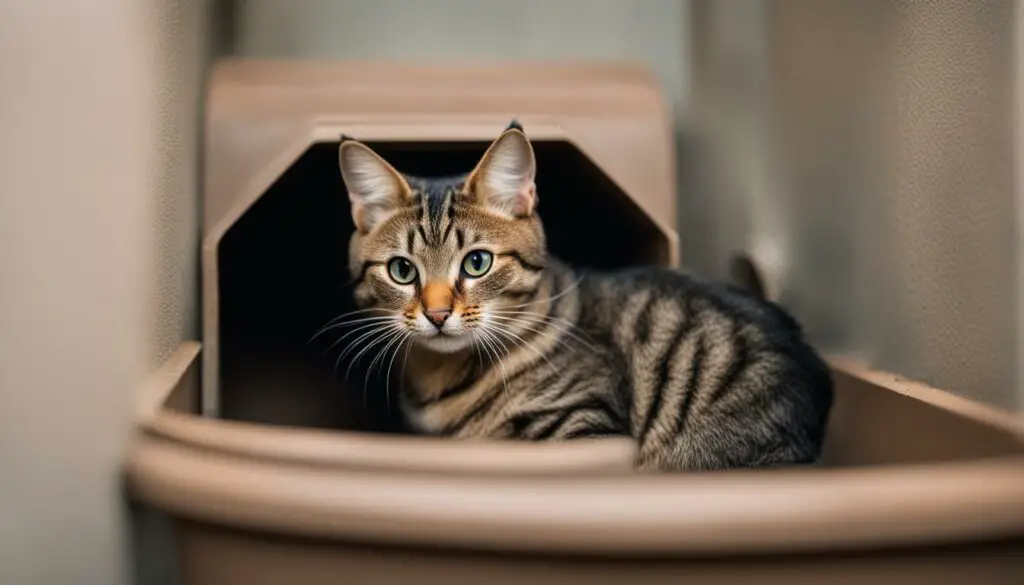
Signs of Underlying Health Issues
When your cat consistently grunts while pooping or exhibits other abnormal behaviors during elimination, it could be a sign of an underlying health issue. It’s essential to be vigilant and look out for additional symptoms that may accompany this behavior.
Some signs to watch for include:
- Blood in the stool
- Vomiting
- Changes in appetite
- Weight loss
If you notice any of these symptoms, it’s crucial to consult with a veterinarian. They can provide a thorough evaluation and diagnosis to determine the underlying cause of your cat’s discomfort.
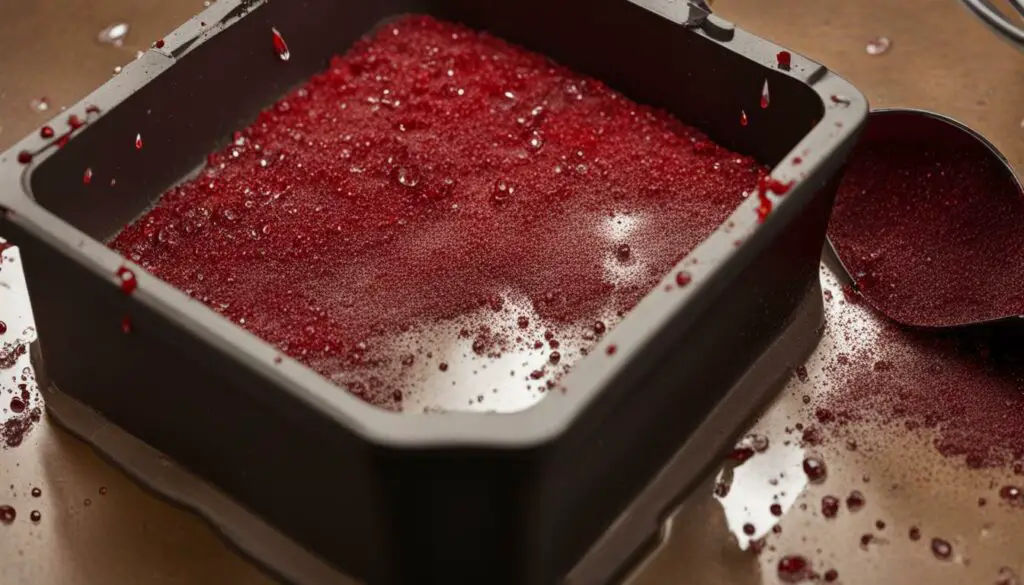
It’s important to remember that cats are masters at hiding signs of illness, and any change in their bathroom behavior should be taken seriously. Regular veterinary check-ups can help detect and address potential health issues early on, ensuring your cat receives the necessary care and treatment.
Section 10: Seeking Veterinary Help
If you notice any concerning symptoms or changes in your cat’s pooping behavior, it’s crucial to consult with a veterinarian. They can perform a thorough examination, conduct diagnostic tests, and provide appropriate treatment for any underlying health issues.
When seeking veterinary help for cat health issues and pooping difficulties, it’s important to provide detailed information about your cat’s symptoms, behavior, and any changes you have observed. This will help the veterinarian make an accurate diagnosis and develop an effective treatment plan.
Remember, cats are experts at hiding signs of illness, so even subtle changes in their pooping habits may indicate an underlying problem. By seeking veterinary help promptly, you can ensure that your cat receives the care they need and prevent any potential complications.
Tips for Promoting Healthy Bowel Movements in Cats
Promoting healthy bowel movements in cats is crucial for their overall well-being. By maintaining a healthy digestive system and ensuring regular and comfortable bowel movements, you can help prevent issues like constipation and promote good gastrointestinal health.
Here are some tips to help you promote healthy bowel movements in your cat:
- Provide a balanced diet: Feed your cat high-quality cat food that is rich in fiber. Fiber helps regulate bowel movements and prevent constipation. Consult with your veterinarian to determine the best diet for your cat’s specific needs.
- Ensure proper hydration: Make sure your cat has access to fresh water at all times. Adequate hydration helps soften the stool and makes it easier to pass through the digestive system.
- Encourage physical activity: Regular exercise helps stimulate bowel movements in cats. Provide your cat with interactive toys and playtime to keep them active and promote healthy digestion.
- Maintain a clean litter box: Cats are clean animals and prefer a clean litter box. Regularly scoop the litter box to ensure your cat has a clean and comfortable space for elimination. A dirty litter box can cause stress and lead to irregular bowel movements.
By implementing these tips, you can help promote regular and healthy bowel movements in your cat, reducing the risk of constipation and other digestive issues. Remember to consult with your veterinarian if you have any concerns about your cat’s bowel movements or overall health.
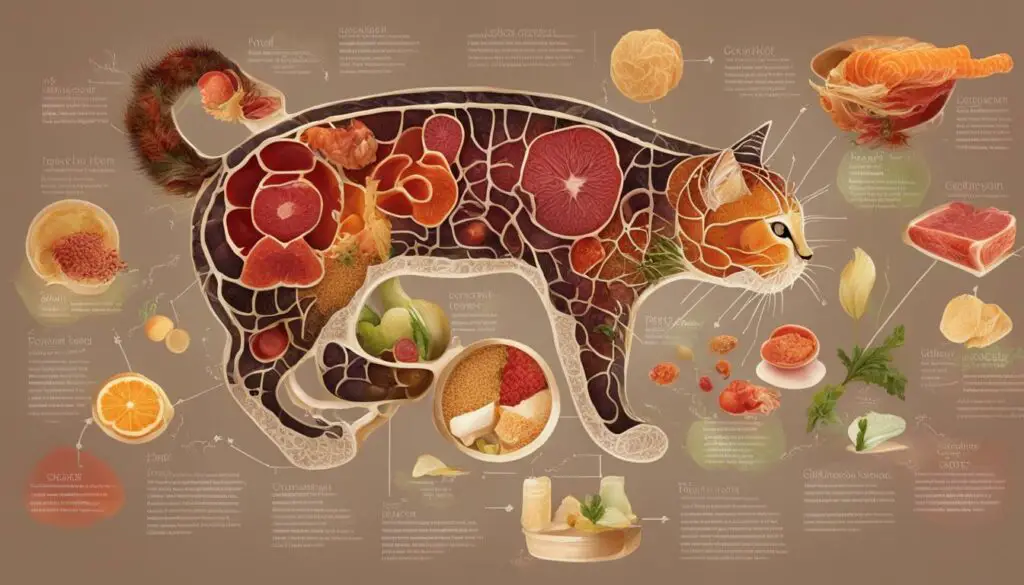
Importance of Regular Vet Check-Ups
Regular veterinary check-ups are essential for maintaining your cat’s overall health, including their digestive system and bowel movements. These routine visits allow for early detection and management of any underlying issues before they become more serious. By scheduling regular check-ups, you can ensure that any potential health problems are identified and addressed promptly.
Veterinarians are trained to recognize the signs and symptoms of various health issues, including those related to the cat’s digestive system. During a check-up, the vet will perform a thorough examination of your cat, which may include checking their weight, temperature, heart rate, and abdomen. They may also conduct diagnostic tests, such as blood work or imaging, to gather more information about your cat’s overall health and identify any potential concerns.
Regular vet check-ups are particularly important for monitoring your cat’s bowel movements. The vet can assess the frequency, consistency, and appearance of your cat’s stools, which can provide valuable insights into their digestive health. They can also offer guidance on maintaining your cat’s optimal bowel movements, such as through dietary adjustments or supplements.
Ensuring Optimal Digestive Health
In addition to regular vet check-ups, there are several steps you can take at home to promote your cat’s digestive health. These include:
- Feeding a balanced diet that is appropriate for your cat’s age, breed, and specific health needs.
- Providing clean and fresh water at all times to prevent dehydration.
- Ensuring your cat gets regular exercise to stimulate their digestive system.
- Maintaining a clean litter box and providing a quiet and stress-free environment for your cat’s bathroom needs.
By following these practices, you can help support your cat’s digestive system and prevent potential issues. However, it’s important to remember that each cat is unique, and their specific needs may vary. If you have any concerns about your cat’s digestive health or bowel movements, it’s always best to consult with your veterinarian for personalized advice and guidance.
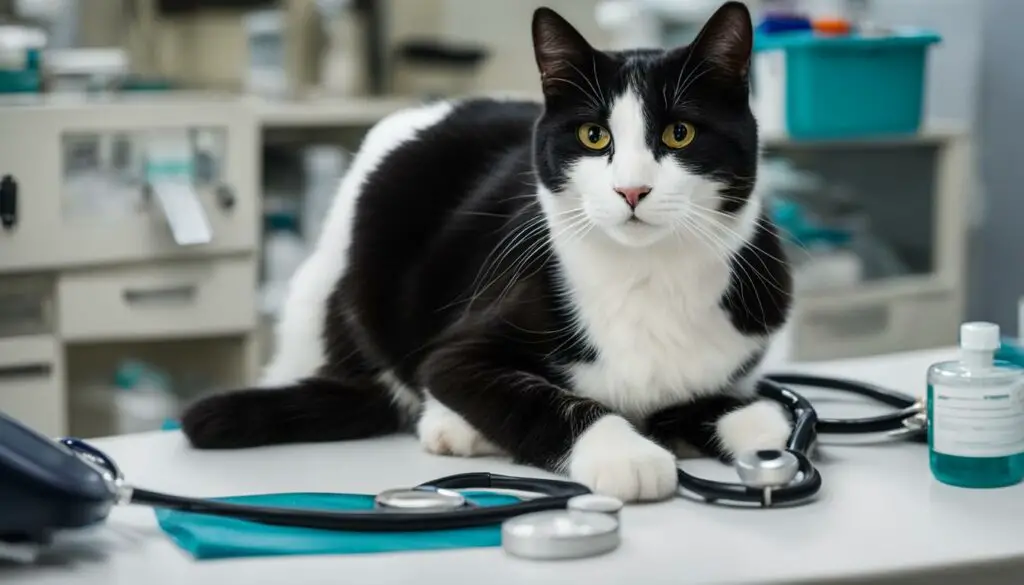
Creating a Comfortable Bathroom Environment for Your Cat
When it comes to your cat’s bathroom habits, creating a comfortable environment is essential for their overall well-being. Cats are creatures of habit, and a stress-free bathroom experience can promote regular and comfortable pooping behavior. Here are some tips to ensure your cat feels at ease during their bathroom time:
Provide a Quiet and Private Area
Cats prefer privacy when they eliminate, so it’s important to provide them with a quiet and secluded area for their litter box. Place the litter box in a low-traffic area of your home where your cat can have some peace and quiet. Avoid placing it near noisy appliances or areas with high foot traffic.
Choose the Right Litter Box
The size and type of litter box can make a difference in your cat’s comfort. Opt for a litter box that is large enough for your cat to move around comfortably and dig without feeling cramped. Some cats prefer covered litter boxes for added privacy, while others may prefer open ones. You can experiment with different types to see what your cat prefers.
Maintain Cleanliness
Cats are clean animals and prefer a tidy bathroom space. Regularly scoop the litter box to remove waste and clumps, as well as replenish the litter as needed. This will help keep the litter box fresh and odor-free, ensuring your cat feels comfortable and encouraged to use it.
By creating a comfortable bathroom environment for your cat, you can help promote regular and stress-free pooping behavior. Remember to observe your cat’s preferences and make adjustments accordingly to ensure they have a pleasant experience every time they use the litter box.
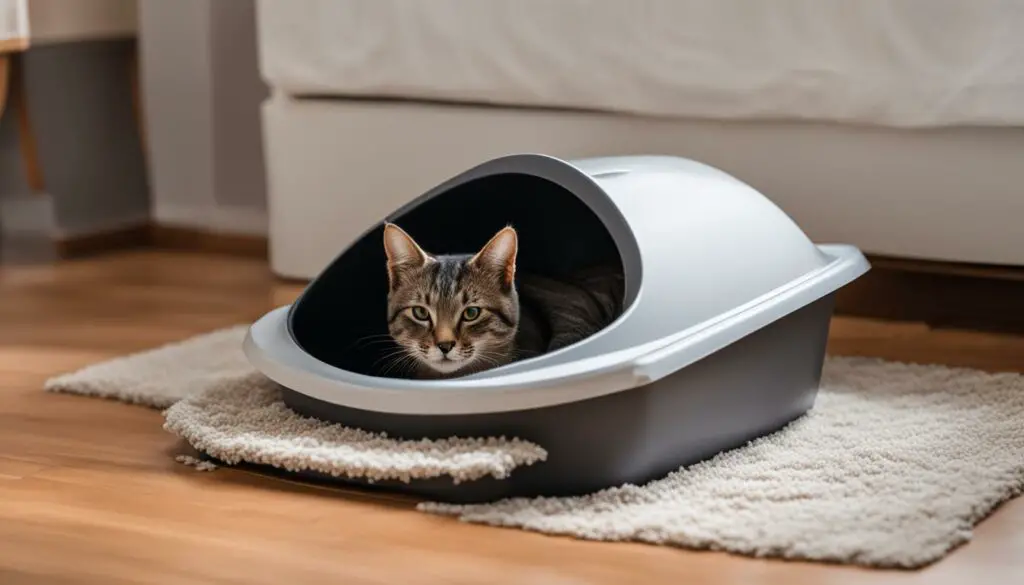
| Possible Comfort Factors | Promotes Comfort | Discourages Comfort |
|---|---|---|
| Quiet and secluded area | ✔️ | |
| Large and spacious litter box | ✔️ | |
| Covered litter box for added privacy | ✔️ | |
| Regular scooping and litter box maintenance | ✔️ | |
| Clean and fresh litter | ✔️ | |
| High foot traffic or noisy area | ❌ | |
| Crowded or small litter box | ❌ | |
| Foul odor in the litter box | ❌ |
Note: This table showcases factors that can either promote or discourage comfort for your cat during their bathroom time.
Understanding Your Cat’s Body Language During Pooping
When it comes to your cat’s bathroom behavior, understanding their body language can provide valuable insights into their overall health and well-being. Paying attention to their cues while they are pooping can help you identify any signs of discomfort, distress, or underlying health issues that may require veterinary attention.
Here are some key indicators to look out for:
- Hunching or crouching posture: If your cat hunches or crouches low to the ground while pooping, it may be a sign of discomfort or pain.
- Excessive straining: Cats typically have smooth and effortless bowel movements. If your cat is visibly straining or appears to be struggling, it could indicate constipation or other digestive issues.
- Avoiding the litter box: Cats are generally clean animals and prefer to use their designated litter box. If your cat avoids using the litter box or seems hesitant to approach it while pooping, it could be a sign of an underlying problem.
By observing these behaviors, you can take prompt action to address any potential health issues and ensure your cat’s comfort during their bathroom routine.
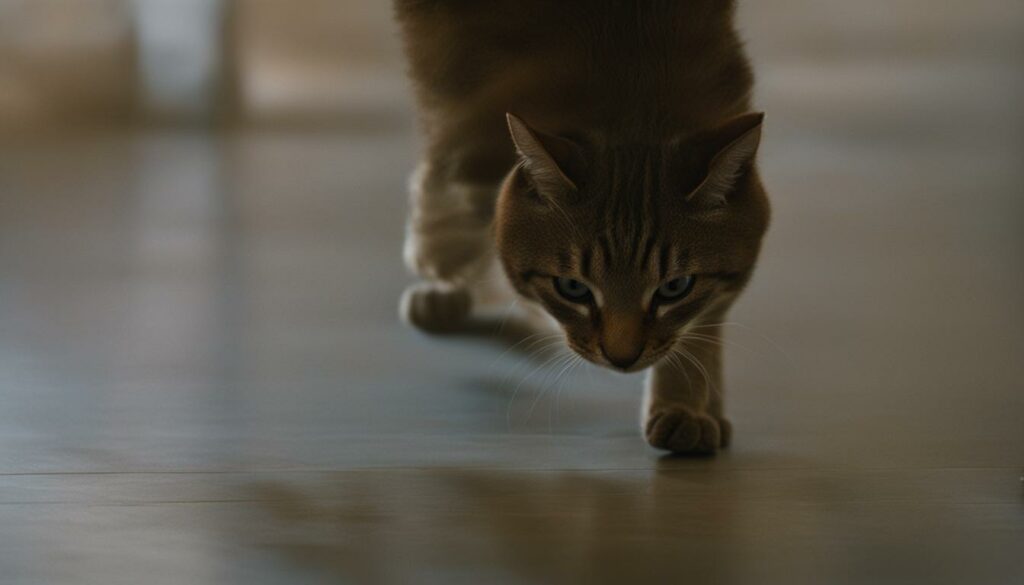
Creating a Comfortable Bathroom Environment for Your Cat
Creating a comfortable and stress-free bathroom environment for your cat is crucial for their overall well-being. Here are some tips to ensure your cat feels safe and at ease while pooping:
- Provide a quiet and private area: Cats prefer privacy while eliminating. Set up their litter box in a secluded area away from noise and foot traffic.
- Choose an appropriate litter box: Ensure the litter box is large enough for your cat to move around comfortably. Cats should be able to enter and exit the litter box without difficulty.
- Maintain cleanliness: Scoop the litter box daily and clean it thoroughly on a regular basis. Cats are more likely to use a clean and hygienic litter box.
By creating a comfortable and clean bathroom environment, you can help alleviate any potential stress or anxiety associated with the pooping process, ensuring a positive experience for your cat.
“Understanding your cat’s body language during pooping is essential for monitoring their health and well-being. By recognizing the subtle cues they exhibit, you can detect any potential issues early on and seek veterinary care if necessary.”
Addressing Cat Pooping Issues Proactively
As a responsible cat owner, it is essential to address any pooping issues your feline friend may be experiencing proactively. By understanding the reasons behind cat pooping behavior and taking appropriate measures, you can promote your cat’s overall health and prevent more serious complications. Here are some key factors to consider:
Regular Veterinary Care: Schedule regular check-ups with your veterinarian to monitor your cat’s digestive system and bowel movements. These visits allow for early detection and management of any underlying health issues that may contribute to pooping difficulties.
Balanced Diet: Provide your cat with a balanced diet that is rich in fiber. This promotes healthy digestion and regular bowel movements. Consult with your veterinarian to ensure you are feeding your cat the appropriate diet for their specific needs.
Proper Hydration: Make sure your cat has access to fresh water at all times. Dehydration can contribute to constipation and other pooping difficulties. Encourage your cat to drink water by placing multiple water bowls around your home or considering a water fountain designed for cats.
Stress-Free Environment: Create a calm and comfortable bathroom environment for your cat. Make sure the litter box is clean and easily accessible. Provide privacy by placing the litter box in a quiet area. Avoid sudden changes in the litter type or location, as these can cause stress and affect your cat’s pooping behavior.
By taking these proactive steps, you can help maintain your cat’s digestive health and ensure regular, comfortable bowel movements. Remember to always consult with your veterinarian if you have any concerns or notice any changes in your cat’s pooping behavior.
| Benefits of Addressing Cat Pooping Issues Proactively | Why It Matters |
|---|---|
| Prevent constipation and other digestive issues | Avoid discomfort and pain for your cat |
| Promote overall health and well-being | Reduce the risk of more serious complications |
| Ensure regular and comfortable bowel movements | Prevent litter box aversion or inappropriate elimination |
| Early detection and management of underlying health issues | Improve your cat’s quality of life |
Conclusion
Understanding why your cat grunts when pooping is important for their overall health. By recognizing the causes, symptoms, and potential underlying health issues, you can take appropriate measures to prevent and manage constipation and create a comfortable environment for your cat’s bathroom needs.
If you have concerns about your cat’s pooping behavior, it is crucial to consult with your veterinarian for proper evaluation and guidance. They can perform a thorough examination, conduct diagnostic tests, and provide appropriate treatment for any underlying health issues.
Remember, regular veterinary care, a balanced diet, proper hydration, and a stress-free environment are key factors in promoting healthy bowel movements for your cat. Taking proactive steps and addressing any pooping issues can help maintain their overall health and prevent more serious complications.
FAQ
Why does my cat grunt when pooping?
Cats may grunt when pooping due to constipation, dietary issues, dehydration, or underlying health conditions affecting their bowel movements.
How can I tell if my cat is constipated?
Look for signs such as infrequent or small bowel movements, straining or grunting during pooping, abdominal discomfort, loss of appetite, and lethargy.
What are the risk factors for cat constipation?
Factors that increase the risk of cat constipation include age, dehydration, lack of dietary fiber, a sedentary lifestyle, and certain health conditions like megacolon or pelvic injury.
How can I prevent and manage cat constipation?
Ensure your cat has a balanced diet rich in fiber, stays hydrated, and gets regular exercise. Consult with your veterinarian for dietary and lifestyle recommendations.
What can I do at home to help a constipated cat?
Home care measures include increasing your cat’s water intake, adding fiber to their diet, providing litter box hygiene, and encouraging physical activity to stimulate bowel movements.
When should I seek veterinary treatment for my cat’s constipation?
If home care measures do not alleviate the constipation, or if your cat has severe symptoms, veterinary intervention may be necessary. Consult with your veterinarian for appropriate treatment options.
Are there other possible causes for my cat grunting when pooping?
Yes, grunting during pooping can also be caused by pain, gastrointestinal disorders, anal gland issues, or urinary tract problems. If you have concerns, consult with your veterinarian for proper evaluation.
What are the signs of underlying health issues in cats?
Look for additional symptoms such as blood in the stool, vomiting, changes in appetite, or weight loss. These may indicate an underlying health issue that requires veterinary attention.
When should I seek veterinary help for my cat’s pooping issues?
If you notice concerning symptoms or changes in your cat’s pooping behavior, it’s crucial to consult with a veterinarian. They can perform a thorough examination and provide appropriate treatment.
How can I promote healthy bowel movements in my cat?
Maintain your cat’s overall health by feeding them a balanced diet, providing plenty of fresh water, encouraging exercise, and ensuring a clean litter box.
Why are regular vet check-ups important for my cat’s digestive system?
Regular veterinary check-ups allow for monitoring of your cat’s overall health, including their digestive system and bowel movements. Early detection and management of any issues are critical.
How can I create a comfortable bathroom environment for my cat?
Provide a quiet and private area, use an appropriate litter box size and type, and maintain cleanliness to promote regular and comfortable pooping behavior.
What should I look for in my cat’s body language during pooping?
Signs of discomfort or distress, such as hunching, excessive straining, or avoiding the litter box, may indicate underlying health issues that require veterinary attention.
How can I address cat pooping issues proactively?
By recognizing and addressing any pooping issues in your cat, you can maintain their overall health and prevent more serious complications. Regular veterinary care, a balanced diet, proper hydration, and a stress-free environment are key factors.

